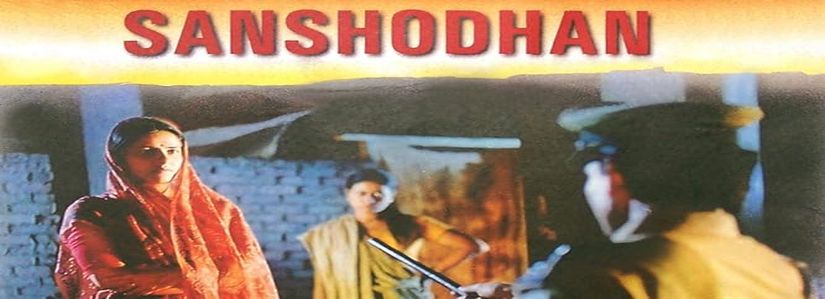Understanding the psychological landscape through the silver screen.
Vidya stands courageously to the might of the zamindar’s goons who intimidate to run over her with the tractors. This scene from the film reminds me of the iconic image of the Tank Man (also known as the Unknown Protester), a Chinese man who stood in front of a column of tanks leaving Tiananmen Square in Beijing in 1989.
It was not an accident that I stumbled upon this film, but during one of the conversations with my friend, Shashi, who is a professor of Gender and Development Studies at TISS, Mumbai, spoke about this film to me and since she enjoyed it, she recommended it to me as well.
Sanshodhan, meaning correction or amendment, at the core is a film about bringing about a ‘change’, a deeper systemic change in the social and moral fabric of the society. The filmmaker attempts at a social intervention through the film to educate the audience about facing the adversities and stand up to oppression with courage by choosing to perform your duties with responsibility. The story is situated against the backdrop of the social conditions of village life. The conflict between the Sarpanch, the power centre, the oppressors, the head of the Panchayat, the local governing body of a village, and the people at the margins, the labourers, the oppressed.
Although I was born in a cosmopolitan city Bombay, and grew up in Mumbai (previously known as Bombay), I haven’t lived a village life, far from it, yet there is a deep longing to live an authentic life connected to my roots. According to Georg Simmel’s “The Metropolis and Mental Life”, while an individual enjoys more freedom in an urban setting but life becomes matter-of-fact, with little consideration for the emotional concerns of the individual and the people around, hence more emotionally isolated.
As Mahatma Gandhi famously said, “the world has enough for everyone’s needs, but not everyone’s greed”. The movie details the oppressive acts of the Zamindar, the power-hungry landlord, also incidentally the Sarpanch of the village, acts of oppression by usurping the lands of the helpless and debt-ridden Kissans, the smaller farmers, and the acts of keeping the labour class helpless, deprived of education, and materially miserable by corruption and nexus with the bureaucracy, evoking Karl Marx’s notion of historical materialism and criticism of the capitalist greed and the oppressive dynamic between the bourgeoisie, the people who control the means of production in a capitalist society and the proletariat, the members of the working class.
The female protagonist, Vidya, is a newly wedded college graduate, married into a new village. The movie begins with a scene, in a very typical and relatable village, of a marriage procession, depicting a new beginning, and the traditional rituals of marriage, a power game played between the bride and the groom, a fun game of finding the ring in the pool of milk, the winner is believed to have an upper hand in the marriage, symbolic of power relations between the individuals.
In this quaint village, things stir-up soon as there is a new law passed in the Parliament of India which mandates a quota of 1/3rd female representation in any village Panchayat, which challenges the hegemonic masculinity. Reservation resorted as a systemic intervention, is a system of ‘affirmative action’ that provides historically disadvantaged and marginalised groups representation in education, employment and politics in India.
The patriarchal power centres of the village, Ratan and Inder Singh, the father-son duo, strategically device and plant the male and female members, Vidya among them, the newly married bride of a poor store owner, Bhanwar, who is indebted to Inder and Ratan Singh. In this way, Ratan and Inder hope to control the women through their respective husbands, erroneously thinking that they will continue to hold the power and work around the situation by planting ‘sham’ members, only to face a series of disappointments and surprises that follow, and to learn about the error in them undermining the female representation and the feminist care ethics (read Carol Gilligan’s the ethics of care).
The story centres around the construction of a ‘school’ or lack thereof. School, the location where knowledge is disseminated, is considered as temple of education and knowledge, Vidya. The village children are deprived of education, hence Avidya persists. The Panchayat is symbolic of the mind, with the conscious and unconscious parts, the current Sarpanch as the Id, the pleasure centre, and Vidya as the Ego, the rational and executive centre and Mahisa as the Superego, the ethical component. The current school is an incomplete structure, symbolic of the dilapidated state of the mind. This reminds me of ”Where Id was, ego shall be” which is a quote by Sigmund Freud who believed that if we attained knowledge of our unconscious thoughts, we would access a more evolved, integrated and truer sense of self.
Our emotions acts as a compass for our life and has an evolutionary purpose. In the face of adversity instead of experiencing destructive ‘unhealthy anger’, Vidya mobilizes her ‘healthy anger’ to bring about a constructive change. Underneath her helpful feelings and behaviours, she holds flexible rational wishes, desires and wants rather than inflexible irrational demands and needs. Vidya accepts the reality, and allows her values, ethics and virtues guide her and commit to her behaviour to bring about a social change, instead of letting rage and aggression overpower her. Vidya is altruistic in a way and not only looks after her own personal needs but contributes to the larger need of the society.
Vidya, evokes the Archetype of Krishna, she propounds the central message of the Bhagwat Geeta: ‘of doing the right thing, to face the adversities and stand up to oppression with courage and to perform duties with responsibility’. As Vidya stands up to the oppressions with great courage, exposes the corruption and the violence exercised through fabrication of documents, exposes the nexus of the Sarpanch and the Bureaucrats, and mobilizes the crowd through her courage and determination.
As the film comes to an end, the conflicts truly bring change. Vidya sees through, with the help of other men and women of the village, the completion of the construction of the school, symbolic of the restoration of the ‘mind’, through Vidya, the right knowledge, that is, wisdom.
Do let me know in the comments section if you have any film in mind which you would like me to analyze.
To join a Film Appreciation Group, please go through this support group intake page, it contains information about, fees, duration, mode of fee payment etc.
Or to Make an Appointment: Call us at +91 702 144 0454 or WhatsApp

